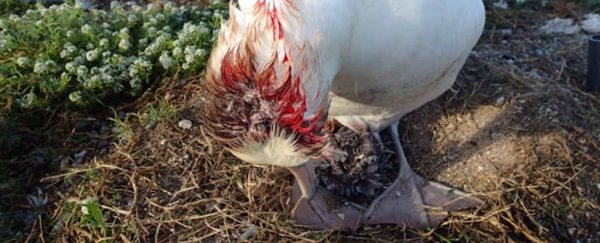For decades, little has gotten in the way of albatrosses nesting and nurturing their young on Midway Atoll, turning it into the most important and successful breeding ground for black-footed and Laysan albatrosses.
But in recent years, the majestic seabirds have fallen victim to gruesome attacks carried out by an unlikely foe: the common house mouse.
Bloodied birds - with open wounds on their heads, necks and backs - were first observed by scientists and volunteers in 2015 on Sand Island, where a majority of Midway's albatross population nests, according to the US Fish and Wildlife Service.
The grisly injuries sparked concern over what could suddenly be threatening the world's largest albatross colony, located about 1,200 miles (1,900 km) northwest of Honolulu.
Initially it was thought that migratory raptors such as owls or hawks were responsible for the attacks, but the type of wounds sustained by the albatrosses did not match, Beth Flint, a wildlife biologist with the Fish and Wildlife Service, said in a video shot by the service.
With officials unable to pinpoint the source of the attacks, Flint said, cameras were set up. The footage showed a horrifying scene: mice climbing on the backs of nesting birds and eating them alive.
The nonnative invasive house mice were first introduced to the island more than 75 years ago, but they had previously coexisted peacefully with the birds, Matt Brown, superintendent for the Fish and Wildlife Service in Papahānaumokuākea Marine National Monument, said in a statement.
"This was something we had never expected to occur," Brown said.
In just a few years, the attacks have spread beyond isolated incidents, killing at least a thousand adult albatrosses and chicks, while injuring countless others and forcing them to abandon their nests, according to the Fish and Wildlife Service.
While a reason behind the sudden attacks has yet to be confirmed, the leading hypothesis is straight out of a horror movie.
Around the time injuries were first reported, the atoll was suffering from a drought, Brad Keitt, director of the oceans and islands program with the American Bird Conservancy, told The Washington Post.
"The mice were looking for sources of liquid, moisture, so actually drinking blood," Keitt said.
He added that it is possible the attacks spread because mice learned from one another, discovering a new way to survive. Mice are omnivores, meaning they will eat any source of food they can find.
But how is it possible that large seabirds - standing almost three feet tall with a wingspan of more than six feet - are falling prey to a rodent?
Nesting albatrosses are particularly vulnerable to attacks because of an intense biological instinct to guard their young, Keitt said.
"The risk that they know is to their egg or chick that they're sitting on," he said. "They want to stay there and protect it. That's their ecological evolutionary response. It's not to run away."
Having nested on the island for so long without facing threats from predators, the birds evolved without any fear or defense mechanisms, the Fish and Wildlife Service said in the statement.
The mice have also exploited a weakness in the albatrosses' defense, attacking from behind where the bird's powerful beak cannot reach them, Keitt said. He added that if a mouse were to walk up to the front of an albatross, it would not stand a chance.
"But a mouse that learns to quickly run up the back and hang out right there, the bird can't do anything about it," he said.
Unfortunately, the attacks by mice are not an unusual occurrence elsewhere, Keitt said, noting that albatrosses on other islands have exhibited similar injuries.
However, attacks at Midway are particularly concerning given how many albatrosses choose the atoll as a nesting spot, the Fish and Wildlife Service said.
Nearly 40 percent of all black-footed albatrosses and 70 percent of all Laysan albatrosses in the world rely on the islands as a haven to rest and raise their young protected from threats such as fisheries and marine debris.
The Fish and Wildlife Service said the attacks pose a serious long-term threat to the atoll's population.
Albatrosses have a very slow reproductive cycle, Keitt said. A male and female have only one egg every one to two years, and both parents invest incredible amounts of time and energy into raising the chick.
Mice, on the other hand, "can potentially reproduce and have several hundred offspring and grandchildren in the period of a year," he said.
In an effort to protect the albatross population, the Fish and Wildlife Service recently announced a plan to eradicate the mice using a combination of rodenticide and trapping.
The proposed strategy is to spread baited pellets containing a rodenticide from helicopters across Sand Island on Midway, the plan states. In some areas, such as where people are, other methods will be used, such as distributing the bait by hand or mechanical traps.
Rodenticide can harm other species of vertebrates aside from mice, including land birds, but the Fish and Wildlife Service said the poisoned pellets will be strategically released at the end of a dry season "when mice are looking for food and the fewest number of bird species are on the island."
A draft of the project's environmental assessment is available for public comment until April 20.
In the meantime, Keitt said temporary control measures have been deployed, including applications of rodenticide in areas where injured birds have been reported.
But, he said, a long-term plan is crucial to the overall survival of the colony.
"Our expectation is that in future years even with control, the impact would grow," he said. "We really can't maintain control at a scale across the island that's safe or effective as the threat grows, as more mice begin to do this."
2018 © The Washington Post
This article was originally published by The Washington Post.
